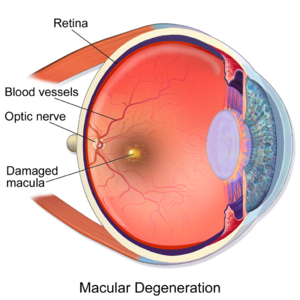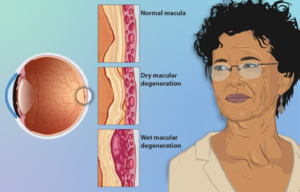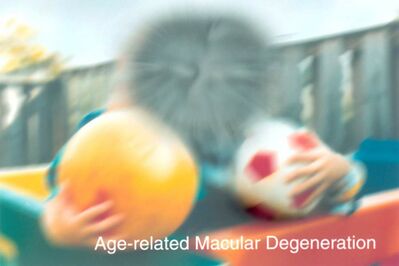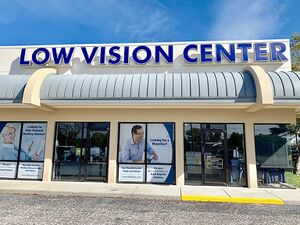Macular Degeneration
Original Editor - Lucinda hampton
Top Contributors - Angeliki Chorti and Lucinda hampton
Introduction[edit | edit source]
Age-related macular degeneration (ARMD) is the most common cause of blindness prevalent in developed countries, particularly in people older than 60 years. Macular degenerative changes involve the central part of the retina that is the fovea. The central vision is affected, resulting in difficulty in reading, driving, etc. It accounts for 8.7% of all types of blindness worldwide.[1]
The number of people living with macular degeneration is expected to reach 196 million worldwide by 2020 and increase to 288 million by 2040.[2]
Image 1: A medical illustration depicting macular degeneration
Types[edit | edit source]
There are two basic types of Macular Degeneration: “dry” and “wet.”
- The dry form of macular degeneration, in which the light sensitive cells of the macula slowly break down, is the most common type, accounting for 90 percent of diagnosed cases.
- Wet macular degeneration accounts for approximately 10 percent of cases, but results in 90 percent of legal blindness. It is considered advanced macular degeneration (there is no early or intermediate stage of wet macular degeneration). Wet macular degeneration is always preceded by the dry form of the disease[2].
Image 2: Depiction of a woman suffering from Age-related Macular Degeneration. A normal macula has been in shown in comparison with the two types of macular degeneration - dry and wet.
Causes[edit | edit source]
The specific factors that cause macular degeneration are not conclusively known, and research into this little understood disease is limited by insufficient funding. At this point, what is known about age-related Macular Degeneration is that the causes are complex, but include both heredity and environment. Several risk factors have been identified and associated with this disease:
- Studies have suggested that inflammation plays a role in the pathogenesis of ARMD
- Hormone replacement therapy or estrogen therapy in women after menopause has been found to have a potential protective effect
- Smoking is a major risk factor for macular degeneration.
- The Age-Related Eye Disease Study (AREDS) documented that antioxidant and zinc supplementation decreases the risk of ARMD progression and vision loss.
- A mild to moderate association between elevated blood pressure and ARMD has been described.
- Atherosclerotic lesions increase the risk of late ARMD. No consistent relationship between cholesterol level and ARMD has been documented[1].
Scientists are working to understand what causes the cells of the macula to deteriorate, seeking a macular degeneration treatment breakthrough.[3]
Symptoms[edit | edit source]
Dry macular degeneration sometimes doesn't cause any symptoms. When symptoms do occur, they may include:
- increasingly blurred vision
- faded colors
- difficulty recognizing faces
- gradual increase in the haziness of central vision
- straight lines appear wavy or crooked
- blurred or blind spot in the center of your field of vision
Symptoms of wet macular degeneration begin abruptly and worsen rapidly. They include:
- distorted vision; straight lines may appear wavy or crooked
- decreased central vision
- decreased intensity or brightness of colors
- blurry or blind spot in your field of vision
Macular degeneration generally does not affect side vision, even in advanced cases[4].
Image 3 and 4: Scenes as they might be viewed by a person with age-related macular degeneration.
Management[edit | edit source]
There is no cure for wet or dry macular degeneration. But treatments can help slow or stop the disease from getting worse. The earlier treatment is started, the more vision is likely to be saved.[4]
A specific high-dose formula of antioxidant vitamins and zinc may delay or prevent intermediate macular degeneration from progressing to the advanced stage.
Management strategies include:
- Pursuing lifestyle changes like dieting, exercise, avoiding smoking, and protecting your eyes from ultraviolet light[3].
- Photodynamic therapy: Treatment that can help control the abnormal blood vessel growth and bleeding in the macula for those with wet macular degeneration
- Physicians have also used: Avastin™ (bevacizumab injection), a cancer therapy manufactured by the company that makes Lucentis, as an “off-label” treatment for wet macular degeneration.
- Vision rehabilitation and low vision aids: Help improve the quality of life for those who are visually impaired[2]
Physiotherapy[edit | edit source]
Older people with AMD have impaired balance, slow visual reaction times, and poor vision, which in combination result in a significantly greater risk of falls than population norms.
Strategies to enhance balance may be particularly beneficial to prevent falls in this group[5]. See Balance training, Otago Exercise Program.
See also Eyesight in the Elderly
References[edit | edit source]
- ↑ 1.0 1.1 Ruia S, Kaufman EJ. Macular Degeneration. StatPearls [Internet]. 2021 Aug 9.Available: https://www.ncbi.nlm.nih.gov/books/NBK560778/ (accessed 12.9.2021)
- ↑ 2.0 2.1 2.2 Bright Focus Foundation Macular Degeneration Available: https://www.brightfocus.org/macular/article/age-related-macular-facts-figures (accessed 12.9.2021)
- ↑ 3.0 3.1 macular org. macular degeneration Available:https://www.macular.org/what-macular-degeneration (accessed 12.9.2021)
- ↑ 4.0 4.1 Harvard health Publishing Macular Degeneration Available:https://www.health.harvard.edu/macular-degeneration2 (accessed 12.11.2021)
- ↑ Szabo SM, Janssen PA, Khan K, Potter MJ, Lord SR. Older women with age‐related macular degeneration have a greater risk of falls: a physiological profile assessment study. Journal of the American Geriatrics Society. 2008 May;56(5):800-7.Available:https://pubmed.ncbi.nlm.nih.gov/18363677/ (accessed 12.9.2021)












